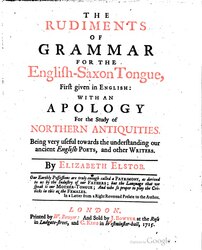File:Rudiments of Grammar for the English-Saxon Tongue (Elstob 1715).djvu
Link to the index page

Size of this JPG preview of this DJVU file: 485 × 600 pixels. Other resolutions: 194 × 240 pixels | 388 × 480 pixels | 621 × 768 pixels | 1,213 × 1,500 pixels.
Original file (1,213 × 1,500 pixels, file size: 29.42 MB, MIME type: image/vnd.djvu, 113 pages)
File history
Click on a date/time to view the file as it appeared at that time.
| Date/Time | Thumbnail | Dimensions | User | Comment | |
|---|---|---|---|---|---|
| current | 10:39, 29 September 2023 |  | 1,213 × 1,500, 113 pages (29.42 MB) | Mårtensås | Imported from Internet Archive by the IA Upload tool job queue |
File usage
The following 48 pages use this file:
- Page:Rudiments of Grammar for the English-Saxon Tongue (Elstob 1715).djvu/1
- Page:Rudiments of Grammar for the English-Saxon Tongue (Elstob 1715).djvu/10
- Page:Rudiments of Grammar for the English-Saxon Tongue (Elstob 1715).djvu/102
- Page:Rudiments of Grammar for the English-Saxon Tongue (Elstob 1715).djvu/103
- Page:Rudiments of Grammar for the English-Saxon Tongue (Elstob 1715).djvu/11
- Page:Rudiments of Grammar for the English-Saxon Tongue (Elstob 1715).djvu/113
- Page:Rudiments of Grammar for the English-Saxon Tongue (Elstob 1715).djvu/12
- Page:Rudiments of Grammar for the English-Saxon Tongue (Elstob 1715).djvu/13
- Page:Rudiments of Grammar for the English-Saxon Tongue (Elstob 1715).djvu/14
- Page:Rudiments of Grammar for the English-Saxon Tongue (Elstob 1715).djvu/15
- Page:Rudiments of Grammar for the English-Saxon Tongue (Elstob 1715).djvu/16
- Page:Rudiments of Grammar for the English-Saxon Tongue (Elstob 1715).djvu/17
- Page:Rudiments of Grammar for the English-Saxon Tongue (Elstob 1715).djvu/18
- Page:Rudiments of Grammar for the English-Saxon Tongue (Elstob 1715).djvu/19
- Page:Rudiments of Grammar for the English-Saxon Tongue (Elstob 1715).djvu/2
- Page:Rudiments of Grammar for the English-Saxon Tongue (Elstob 1715).djvu/20
- Page:Rudiments of Grammar for the English-Saxon Tongue (Elstob 1715).djvu/21
- Page:Rudiments of Grammar for the English-Saxon Tongue (Elstob 1715).djvu/22
- Page:Rudiments of Grammar for the English-Saxon Tongue (Elstob 1715).djvu/23
- Page:Rudiments of Grammar for the English-Saxon Tongue (Elstob 1715).djvu/24
- Page:Rudiments of Grammar for the English-Saxon Tongue (Elstob 1715).djvu/25
- Page:Rudiments of Grammar for the English-Saxon Tongue (Elstob 1715).djvu/26
- Page:Rudiments of Grammar for the English-Saxon Tongue (Elstob 1715).djvu/27
- Page:Rudiments of Grammar for the English-Saxon Tongue (Elstob 1715).djvu/28
- Page:Rudiments of Grammar for the English-Saxon Tongue (Elstob 1715).djvu/29
- Page:Rudiments of Grammar for the English-Saxon Tongue (Elstob 1715).djvu/3
- Page:Rudiments of Grammar for the English-Saxon Tongue (Elstob 1715).djvu/30
- Page:Rudiments of Grammar for the English-Saxon Tongue (Elstob 1715).djvu/31
- Page:Rudiments of Grammar for the English-Saxon Tongue (Elstob 1715).djvu/32
- Page:Rudiments of Grammar for the English-Saxon Tongue (Elstob 1715).djvu/33
- Page:Rudiments of Grammar for the English-Saxon Tongue (Elstob 1715).djvu/34
- Page:Rudiments of Grammar for the English-Saxon Tongue (Elstob 1715).djvu/35
- Page:Rudiments of Grammar for the English-Saxon Tongue (Elstob 1715).djvu/36
- Page:Rudiments of Grammar for the English-Saxon Tongue (Elstob 1715).djvu/37
- Page:Rudiments of Grammar for the English-Saxon Tongue (Elstob 1715).djvu/38
- Page:Rudiments of Grammar for the English-Saxon Tongue (Elstob 1715).djvu/39
- Page:Rudiments of Grammar for the English-Saxon Tongue (Elstob 1715).djvu/4
- Page:Rudiments of Grammar for the English-Saxon Tongue (Elstob 1715).djvu/40
- Page:Rudiments of Grammar for the English-Saxon Tongue (Elstob 1715).djvu/41
- Page:Rudiments of Grammar for the English-Saxon Tongue (Elstob 1715).djvu/42
- Page:Rudiments of Grammar for the English-Saxon Tongue (Elstob 1715).djvu/43
- Page:Rudiments of Grammar for the English-Saxon Tongue (Elstob 1715).djvu/44
- Page:Rudiments of Grammar for the English-Saxon Tongue (Elstob 1715).djvu/5
- Page:Rudiments of Grammar for the English-Saxon Tongue (Elstob 1715).djvu/6
- Page:Rudiments of Grammar for the English-Saxon Tongue (Elstob 1715).djvu/7
- Page:Rudiments of Grammar for the English-Saxon Tongue (Elstob 1715).djvu/8
- Page:Rudiments of Grammar for the English-Saxon Tongue (Elstob 1715).djvu/9
- Index:Rudiments of Grammar for the English-Saxon Tongue (Elstob 1715).djvu



